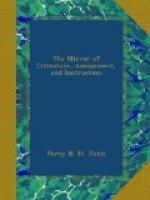* * * * *
PHILOSOPHY OF LONDON.
The Quadrant
The principle of suum cuique is felicitously enforced in that ostentatious but rather heavy piece of architecture, the Regent Quadrant, the pillars of which exhibit from time to time different colours, according to the fancy of the shop-owners to whose premises respectively they happen to belong. Thus, Mr. Figgins chooses to see his side of a pillar painted a pale chocolate, while his neighbour Mrs. Hopkins insists on disguising the other half with a coat of light cream colour, or haply a delicate shade of Dutch pink; so that the identity of material which made it so hard for Transfer, in Zeluco, to distinguish between his metal Venus and Vulcan, is often the only incident that the two moieties have in common.
Squares.
The few squares that existed in London antecedent to 1770, were rather sheep-walks, paddocks, and kitchen gardens, than any thing else. Grosvenor Square in particular, fenced round with a rude wooden railing, which was interrupted by lumpish brick piers at intervals of every half-dozen yards, partook more of the character of a pond than a parterre; and as for Hanover Square, it had very much the air of a sorry cow-yard, where blackguards were to be seen assembled daily, playing at husselcap up to their ankles in mire. Cavendish Square was then for the first time dignified with a statue, in the modern uniform of the Guards, mounted on a charger, a l’antique, richly gilt and burnished; and Red Lion Square, elegantly so called from the sign of an ale-shop at the corner, presented the anomalous appendages of two ill-constructed watch-houses at either end, with an ungainly, naked obelisk in the centre, which, by the by, was understood to be the site of Oliver Cromwell’s re-interment. St. James’s Park abounded in apple-trees, which Pepys mentions having laid under contribution by stealth, while Charles and his queen were actually walking within sight of him. The quaint style of this old writer is sometimes not a little entertaining. He mentions having seen Major-General Harrison “hanged, drawn, and quartered at Charing-Cross, he (Harrison) looking as cheerful as any man could in that condition.” He also gravely informs us that Sir Henry Vane, when about to be beheaded on Tower Hill, urgently requested the executioner to take off his head so as not to hurt a seton which happened to be uncicatrized in his neck!
Modern Building.
We are the contemporaries of a street-building generation, but the grand maxim of the nineteenth century, in their management of masonry, as in almost every thing else, as far as we can discover, appears to lie in that troublesome line of Macbeth’s soliloquy, ending with, “’twere well it were done quickly.” It is notorious that many of the leases of new dwelling-houses contain a clause against dancing, lest the premises should suffer from a mazurka,




